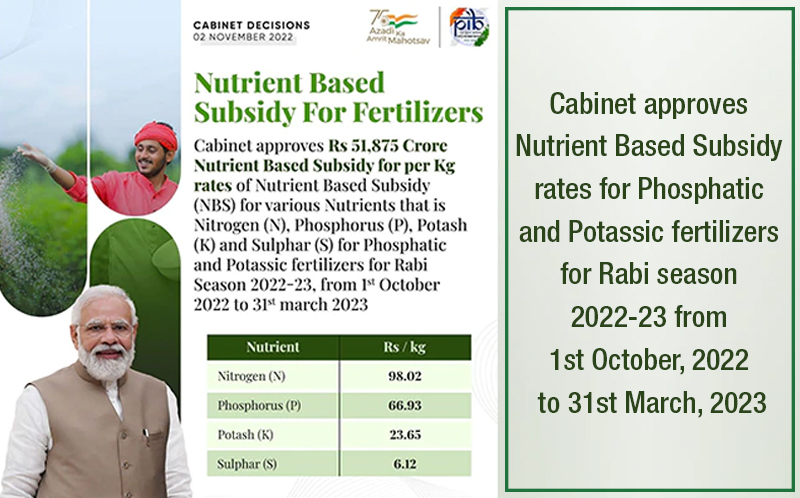October 31, 2023
Recent Approval of Nutrient-Based Subsidy Rates for Rabi and Kharif Seasons (2022-23): A Balanced Approach for Agricultural Prosperity

Introduction
- The Union Cabinet’s recent nod to the Nutrient-Based Subsidy (NBS) rates for Rabi and Kharif seasons in 2022-23 marks a pivotal moment in India’s agricultural policy. This article delves into the NBS regime, outlining its objectives and challenges, while underscoring the necessity of a balanced approach to tackle economic, environmental, and distribution concerns.
Understanding the Nutrient-Based Subsidy (NBS) Regime
Subsidized Fertilizers
- Farmers benefit from fertilizers offered at reduced rates, determined by their nutrient content, including Nitrogen, Phosphorus, Potash, and Sulphur.
Additional Subsidy
- Fertilizers enriched with supplementary nutrients like molybdenum and zinc receive extra financial support.
Key Features of Nutrient-Based Subsidy (NBS)
Targeted Subsidy
- Fertilizers are subsidized based on their nutrient composition, focusing on essential elements like Nitrogen (N), Phosphorus (P), Potash (K), and Sulphur (S).
Additional Subsidy for Fortified Fertilizers
- Fertilizers containing secondary and micronutrients, such as molybdenum (Mo) and zinc, receive additional subsidies.
Annual Determination of Rates
- The government annually announces subsidy rates for Phosphatic and Potassic (P&K) fertilizers, considering factors like international and domestic prices, exchange rates, and inventory levels.
Promotion of Balanced Fertilization
- NBS endeavors to achieve an optimal nutrient balance (N:P:K = 4:2:1) in fertilization, thereby enhancing soil health and crop yields.
Implementation Authority
- Administered by the Department of Fertilizers, Ministry of Chemicals & Fertilizers since April 2010.
Rationale for Nutrient-Based Subsidy (NBS)
Efficient Resource Allocation
- NBS ensures subsidies are allocated to farmers based on their specific nutrient requirements, encouraging judicious fertilizer use.
Optimal NPK Fertilization
- By advocating for a balanced nutrient ratio (N:P:K = 4:2:1), NBS aims to improve soil health, resulting in augmented crop yields and farmer income.
Sustainable Agricultural Practices
- The policy supports environmentally sustainable practices by discouraging imbalanced fertilizer use, reducing soil degradation, and minimizing nutrient runoff.
Food Security
- The availability of subsidized P&K fertilizers during the crucial Kharif season bolsters agricultural productivity, thus contributing to food security in India.
Long-Term Soil Health
- NBS advocates for a holistic approach to soil management, addressing nutrient deficiencies and ensuring the enduring fertility of agricultural land.
Nutrient-Based Subsidy (NBS) Rates Approval
Rabi Season 2022-23
- Subsidy rates have been sanctioned for vital nutrients including Nitrogen, Phosphorus, Potash, and Sulphur.
Kharif Season 2023
- Approval granted for Phosphatic and Potassic (P&K) Fertilizers.
Objective of NBS Policy
Balanced Fertilization
- Aims to achieve an optimal balance (N:P:K=4:2:1) to enhance soil health and crop yield.
Increased Income
- Boosts farmers’ income through improved productivity.
Reducing Subsidy Burden
- Expects rational fertilizer use to ease the subsidy burden on the government.
Significance of NBS Subsidy
Agricultural Support
- Ensures affordable availability of DAP and other P&K fertilizers during Kharif for enhanced agricultural productivity.
Resource Allocation
- Crucial for efficient allocation, directing subsidies where needed for sustainable agriculture.
Challenges with NBS Policy
Economic and Environmental Costs
- High subsidy burden strains the economy, leading to imbalanced fertilizer use and environmental issues.
Black Marketing and Diversion
- Subsidized urea faces illegal sale and smuggling to non-agricultural users.
Leakage and Misuse
- Inefficient distribution can lead to fertilizer misuse or non-delivery to intended farmers.
Regional Disparities
- A uniform policy may not cater to diverse regional needs, impacting nutrient application and productivity.
Way Forward for NBS Policy
Uniform Policy
- A necessary step for essential nutrients (N, P, K) with considerations for regional variations.
Cash Subsidy Alternative
- A long-term shift to a per-acre cash subsidy for flexible fertilizer purchase.
Balancing Act
- Striking a balance between price control, affordability, and sustainable nutrient management is paramount for NBS success.
Conclusion
- The recent endorsement of NBS rates for Rabi and Kharif seasons is a significant stride towards ensuring sustainable and prosperous agriculture in India. Balancing economic considerations, environmental concerns, and equitable distribution is crucial for the policy’s effectiveness and long-term success. By fostering judicious fertilizer use, NBS stands as a cornerstone in the path towards a thriving agricultural sector.
January 30, 2025
January 20, 2025
January 14, 2025
